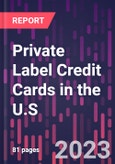The “Private Label Credit Cards in the U.S., 13th Edition,” offers a deeply detailed analysis of the shifting strategies and emerging opportunities and challenges confronting private label card issuers and their merchant partners.
Rebounding from declining transaction volumes in 2018-2020, the private label credit card market experienced growth in both 2021 and 2022. Growth will continue through 2025 with private label credit card nominal purchase volume growing a total of 9.8% through 2025 and card outstandings growing a total of 9.7% during the period.”
For the six largest private label credit card issuers (Synchrony Financial, Citibank’s Citi Retail Services, Capital One, TD Bank, Bread Financial and Wells Fargo), purchase volume will total $339.9 billion in 2025 and card outstandings will reach $172.9 billion in 2025.
Revitalizing growth is coming to the payment segment from both medical credit cards and new credit bundlings providing small to mid-sized merchants private label credit cards and buy-now, pay-later (BNPL) financing through point-of-sale.
In the past five years, Buy-now, pay-later (BNPL) loans have offered buyers zero-interest short-term installment loans that have created windshear for both network-branded and private label credit cards. The report estimates displacement of credit card purchase volume by BNPL totaled $143 billion in 2021 and will reach $279 billion in 2023.
Despite financing inroads made by BNPL, private label card issuers and merchants continue to benefit from the customer loyalty and additional revenue associated with the ownership and use of store credit cards. They have also benefited from the introduction of new products (medical credit cards) and the integration of private label BNPL and credit cards in their suite of products available to merchants.
Like other PLCCs, medical credit cards run on a closed-loop systems and are accepted at only specific healthcare providers. Unlike traditional store cards which feature the name of a retailer, medical credit cards feature the name of their own brand.
While many financing companies offer deferred interest financing for medical and dental procedures, currently, only three private label credit card issuers offer medical/healthcare credit cards: Synchrony, Bread Financial and Wells Fargo.
Synchrony offers the CareCredit Credit Card, Bread Financial’s Comenity Capital Bank offers the Alphaeon Credit Card, DentalFirst Financing Credit Card, and Dental Alliance Credit Card, and Wells Fargo offers its Health Advantage Credit Card.
CareCredit is by far the largest credit card product in this market, growing from 4.4 million cardholders and 177,000 providers in 2013 to 11.7 million cardholders and over 250,000 enrolled healthcare providers in 2023.
These breakthrough innovations are delivering positive growth in the nick of time. In addition to macro-economic challenges facing the US economy and US consumer confidence and spending, there are issues specific to the private label credit card industry that must be addressed.
Private label credit card debt charge-off and delinquency rates are higher in the summer of 2023 than they were pre-pandemic. This puts strain on the risk management strategies of issuers.
There may be consumer pushback against rising interest rates on unpaid PLCC balances. For many years, the industry’s consensus maximum interest rate cap on a store-only credit card was 29.99%. But that barrier was broken in 2022 and while most 30%+ interest rate cards are retail co-branded cards, they are appearing with greater frequency across issuer portfolios.
Late fee charges may be capped which would eliminate 75% of the card industry’s late fee revenue. Credit card issuers are united in challenging the Consumer Financial Protection Bureau’s (CFPB) proposed $8 late fee cap citing its capriciousness, its lack of a deterrent effect on cardholder behavior, its elimination of inflation-adjustments for ensuing years, and its enormous impact on the profitability of credit card issuers.
The CFPB estimates that card late fees for general purpose and private label credit card cost consumers approximately $12 billion each year. Its new rule would eliminate $9 billion of those late fees.
Table of Contents
Companies Mentioned
- American Eagle
- Best Buy
- Bread Financial
- Capital One
- Citi Retail Services
- Forever 21
- Home Depot
- Kohl's
- Macy's
- Synchrony Financial
- Target
- TD Bank
- Wells Fargo








